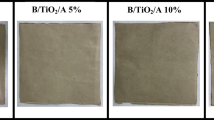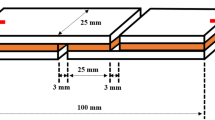Abstract
Development of self-sanitizing cellulose and cellulose paper-based products will increase human safety and hygiene. In the present work, a softwood bleached kraft pulp (SBKP) was oxidized by 2,2,6,6-tetramethylpiperidine-1-oxyl radical (TEMPO)-mediated oxidation in water at pH 10 at two NaClO addition levels (3 and 5 mmol g−1 based on the dry weight of SBKP). The fibrous TEMPO-oxidized SBKPs (TO-SBKPs) were subsequently incorporated with silver nanoparticles (AgNPs) by soaking in aqueous silver nitrate (AgNO3) solution and subsequent thermal reduction. The C=O absorption band in FTIR spectra of AgNP-containing TO-SBKPs increased with increasing Ag content, showing that the C2/C3 hydroxy groups in TO-SBKPs were oxidized to ketones by reduction of Ag+ ions to AgNPs during heating at 100 °C for 1 h. Scanning electron microscopy images showed that the AgNPs were almost homogenously distributed on the surface of each TO-SBKP fiber with an average diameter of 32–40 nm regardless of different Ag contents. Handsheets were prepared from SBKP and the AgNP-containing TO-SBKP at various weight ratios. The handsheets showed sufficient antimicrobial activities against a Gram-negative Escherichia coli strain and a Gram-positive Staphylococcus aureus strain. The tensile strength of the handsheets was significantly improved by mixing the AgNP-containing TO-SBKP with SBKP. The 20% TO-SBKP/Ag-containing SBKP sheets were optimal in terms of efficient antimicrobial activities and good mechanical properties. Thus, the AgNP-containing TO-SBKP sheets have potential for use as antimicrobial paper and related packaging materials produced using the conventional papermaking process.
Graphic abstract









Similar content being viewed by others
References
Amini E, Azadfallah M, Layeghi M, Talaei-Hassanloui R (2016) Silver-nanoparticle-impregnated cellulose nanofiber coating for packaging paper. Cellulose 23:557–570. https://doi.org/10.1007/s10570-015-0846-1
Chitbanyong K, Pisutpiched S, Khantayanuwong S, Theeragool G, Puangsin B (2020) TEMPO-oxidized cellulose nanofibril film from nano-structured bacterial cellulose derived from the recently developed thermotolerant Komagataeibacter xylinus C30 and Komagataeibacter oboediens R37–9 strains. Int J Biol Macromol 163:1908–1914. https://doi.org/10.1016/j.ijbiomac.2020.09.124
Dai L et al (2017) TEMPO-oxidized waste cellulose as reinforcement for recycled fiber networks. Ind Eng Chem Res 56:15065–15071. https://doi.org/10.1021/acs.iecr.7b04135
Feng J et al (2014) Antimicrobial activity of silver nanoparticles in situ growth on TEMPO-mediated oxidized bacterial cellulose. Cellulose 21:4557–4567. https://doi.org/10.1007/s10570-014-0449-2
Fukuzumi H, Saito T, Okita Y, Isogai A (2010) Thermal stabilization of TEMPO-oxidized cellulose. Polym Degrd Stab 95:1502–1508. https://doi.org/10.1016/j.polymdegradstab.2010.06.015
Ghorbani HR (2017) Preparation of chitosan-copper nanoparticles coated Kraft paper, characterization and its antimicrobial activity. J Nanoanal 4:320–323
Hiraoki R, Ono Y, Saito T, Isogai A (2015) Molecular mass and molecular-mass distribution of TEMPO-oxidized celluloses and TEMPO-oxidized cellulose nanofibrils. Biomacromol 16:675–681. https://doi.org/10.1021/bm501857c
Hirota M, Furihata K, Saito T, Kawada T, Isogai A (2010) Glucose/glucuronic acid alternative co-polysaccharides prepared from TEMPO-oxidized native celluloses by surface peeling. Angew Chem Int Ed 49:7670–7672. https://doi.org/10.1002/anie.201003848
Ifuku S, Tsuji M, Morimoto M, Saimoto H, Yano H (2009) Synthesis of silver nanoparticles templated by TEMPO-mediated oxidized bacterial cellulose nanofibers. Biomacromol 10:2714–2717. https://doi.org/10.1021/bm9006979
Islam MS et al (2018) Mussel-inspired immobilization of silver nanoparticles toward antimicrobial cellulose paper. ACS Sustain Chem Eng 6:9178–9188. https://doi.org/10.1021/acssuschemeng.8b01523
Isogai A (2021) Emerging nanocellulose technologies: recent developments. Adv Mater 33:2000630. https://doi.org/10.1002/adma.20200063
Isogai A, Saito T, Fukuzumi H (2011) TEMPO-oxidized cellulose nanofibers. Nanoscale 3:71–85. https://doi.org/10.1039/C0NR00583E
Isogai A, Hänninen T, Fujisawa S, Saito T (2018) Catalytic oxidation of cellulose with nitroxyl radicals under aqueous conditions. Prog Polym Sci 86:122–148. https://doi.org/10.1016/j.progpolymsci.2018.07.007
Ito H, Sakata M, Hongo C, Matsumoto T, Nishino T (2018) Cellulose nanofiber nanocomposites with aligned silver nanoparticles. Nanocomposites 4:167–177. https://doi.org/10.1080/20550324.2018.1556912
Jaisai M, Baruah S, Dutta J (2012) Paper modified with ZnO nanorods–antimicrobial studies. Beilstein J Nanotechnol 3:684–691. https://doi.org/10.3762/bjnano.3.78
Kim JS et al (2007) Antimicrobial effects of silver nanoparticles. Nanomed-Nanotechnol 3:95–101. https://doi.org/10.1016/j.nano.2006.12.001
Kitaoka T, Isogai A, Onabe F (1999) Chemical modification of pulp fibers by TEMPO-mediated oxidation. Nord Pulp Pap Res J 14:279–284. https://doi.org/10.3183/npprj-1999-14-04-p279-284
Klemm D, Heublein B, Fink HP, Bohn A (2005) Cellulose: fascinating biopolymer and sustainable raw material. Angew Chem Int Ed 44:3358–3393. https://doi.org/10.1002/anie.200460587
Knetsch ML, Koole LH (2011) New strategies in the development of antimicrobial coatings: the example of increasing usage of silver and silver nanoparticles. Polymers 3:340–366. https://doi.org/10.3390/polym3010340
Kobayashi Y, Gondo T, Yamamoto M, Saito T, Isogai A (2016) Fundamental properties of handsheets containing TEMPO-oxidized pulp in various weight ratios. Nord Pulp Pap Res J 31:248–254. https://doi.org/10.3183/npprj-2016-31-02-p248-254
Kostic MM, Milanovic JZ, Baljak MV, Mihajlovski K, Kramar A (2014) Preparation and characterization of silver-loaded hemp fibers with antimicrobial activity. Fibers Polym 15:57–64. https://doi.org/10.1007/s12221-014-0057-7
Koziróg A, Brycki B, Olejnik K, Wysocka-Robak A, Dębska-Winkler P (2019) Cellulose products modified with monomeric and gemini surfactants: antimicrobial aspects. Cellulose 26:5559–5570. https://doi.org/10.1007/s10570-019-02475-0
Kuramae R, Saito T, Isogai A (2014) TEMPO-oxidized cellulose nanofibrils prepared from various plant holocelluloses. React Funct Polym 85:126–133. https://doi.org/10.1016/j.reactfunctpolym.2014.06.011
Li T, Chen C, Brozena AH, Zhu JY, Xu L, Driemeier C, Dai J, Rojas OJ, Isogai A, Wågberg L, Hu L (2021) Developing fibrillated cellulose as a sustainable technological material. Nature 590:47–56. https://doi.org/10.1038/s41586-020-03167-7
Martins NC et al (2012) Electrostatic assembly of Ag nanoparticles onto nanofibrillated cellulose for antibacterial paper products. Cellulose 19:1425–1436. https://doi.org/10.1007/s10570-012-9713-5
Milanović J, Mihajlovski K, Nikolić T, Kostić M (2016) Antimicrobial cotton fibers prepared by tempo-mediated oxidation and subsequent silver deposition. Cell Chem Technol 50:905–914
Nakamura Y, Ono Y, Saito T, Isogai A (2019) Characterization of cellulose microfibrils, cellulose molecules, and hemicelluloses in buckwheat and rice husks. Cellulose 26:6529–6541. https://doi.org/10.1007/s10570-019-02560-4
Nokkrut BO, Pisuttipiched S, Khantayanuwong S, Puangsin B (2019) Silver nanoparticle-based paper packaging to combat black anther disease in orchid flowers. Coatings 9:40. https://doi.org/10.3390/coatings9010040
Ono Y, Isogai A (2020) Analysis of celluloses, plant holocelluloses, and wood pulps by size-exclusion chromatography/multi-angle laser-light scattering. Carbohydr Polym 251:117045. https://doi.org/10.1016/j.carbpol.2020.117045
Puangsin B, Fujisawa S, Kuramae R, Saito T, Isogai A (2013) TEMPO-mediated oxidation of hemp bast holocellulose to prepare cellulose nanofibrils dispersed in water. J Polym Environ 21:555–563. https://doi.org/10.1007/s10924-012-0548-9
Rodriguez A, Batlle R, Nerin C (2007) The use of natural essential oils as antimicrobial solutions in paper packaging. Part II Prog Org Coat 60:33–38. https://doi.org/10.1016/j.porgcoat.2007.06.006
Shimizu M, Saito T, Isogai A (2016) Water-resistant and high oxygen-barrier nanocellulose films with interfibrillar cross-linkages formed through multivalent metal ions. J Membr Sci 500:1–7. https://doi.org/10.1016/j.memsci.2015.11.002
Shinoda R, Saito T, Okita Y, Isogai A (2012) Relationship between length and degree of polymerization of TEMPO-oxidized cellulose nanofibrils. Biomacromol 13:842–849. https://doi.org/10.1021/bm2017542
Sone A, Saito T, Isogai A (2016) Preparation of aqueous dispersions of TEMPO-oxidized cellulose nanofibrils with various metal counterions and their super deodorant performances. ACS Macro Lett 5:1402–1405. https://doi.org/10.1021/acsmacrolett.6b00786
Šumiga B, Šumiga B, Ravnjak D, Podgornik BB (2019) Antimicrobial paper coatings containing microencapsulated cymbopogon citratus oil. Coatings 9:470. https://doi.org/10.3390/coatings9080470
Taglietti A et al (2012) Antibacterial activity of glutathione-coated silver nanoparticles against gram positive and Gram negative bacteria. Langmuir 28:8140–8148. https://doi.org/10.1021/la3003838
Tie L et al (2020) Versatile polypeptide-functionalized plasmonic paper as synergistic biocompatible and antimicrobial nanoplatform. Molecules 25:3182. https://doi.org/10.3390/molecules25143182
Wu CN et al (2018) TEMPO-oxidized bacterial cellulose pellicle with silver nanoparticles for wound dressing. Biomacromol 19:544–554. https://doi.org/10.1021/acs.biomac.7b01660
Xu Y, Li S, Yue X, Lu W (2018) Review of silver nanoparticles (AgNPs)-cellulose antibacterial composites. BioResources 13:2150–2170
Yang G, Cai J, Geng Y, Xu B, Zhang Q (2020) Cu-modified ZSM zeolite has synergistic flame retardance, smoke suppression, and catalytic conversion effects on pulp fiber after ammonium polyphosphate flame-retardant treatment. ACS Sustain Chem Eng 8:14365–14376. https://doi.org/10.1021/acssuschemeng.0c03920
Acknowledgments
This work was financially supported by the Office of the Ministry of Higher Education, Science, Research, and Innovation, and the Thailand Science Research and Innovation through the Kasetsart University Reinventing University Program 2021 and Kasetsart University Research and Development Institute (KURDI). The authors also thank Edanz (https://jp.edanz.com/ac) for editing a draft of this manuscript.
Funding
Office of the Ministry of Higher Education, Science, Research, and Innovation, the Thailand Science Research and Innovation through the Kasetsart University Reinventing University Program 2021, Kasetsart University Research and Development Institute (KURDI).
Author information
Authors and Affiliations
Corresponding authors
Ethics declarations
Conflict of interest
The authors declare that they have no conflict of interest.
Additional information
Publisher's Note
Springer Nature remains neutral with regard to jurisdictional claims in published maps and institutional affiliations.
Supplementary Information
Below is the link to the electronic supplementary material.
Rights and permissions
About this article
Cite this article
Puangsin, B., Chitbanyong, K., Yimlamai, P. et al. Silver-nanoparticle-containing handsheets for antimicrobial applications. Cellulose 29, 2005–2016 (2022). https://doi.org/10.1007/s10570-021-04403-7
Received:
Accepted:
Published:
Issue Date:
DOI: https://doi.org/10.1007/s10570-021-04403-7




